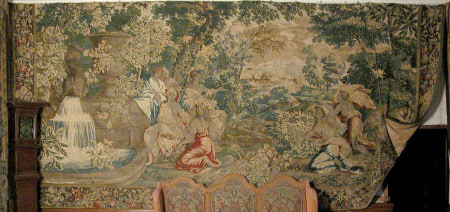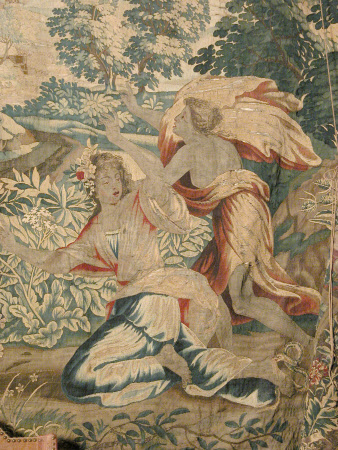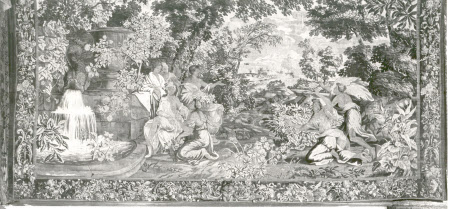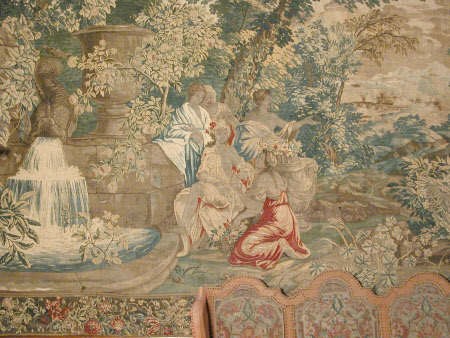The Death of Eurydice
possibly Jan van der Goten (b.1642)
Category
Tapestries
Date
circa 1690 - circa 1710
Materials
Tapestry, wool and silk, 6 warps per cm
Measurements
2430 x 5260 mm
Order this imageCollection
Cotehele, Cornwall
NT 348246
Summary
Tapestry, wool and silk, 6 warps per cm, The Death of Eurydice, Jan or Jacob van der Goten, Antwerp, c. 1690-1710. On the left a group of five nymphs recline beside a fountain formed of a stone fish with a large urn beside it. Two lean against the stone parapets, one reaches out her arms and one kneels to offer flowers from a basket to the nymph in the centre, who has flowers in her hair and sits facing the viewer with one breast bare. An urn filled with flowers and decorated with a ram’s head lies on the ground beside the nymphs. On the right is a second group of two nymphs, one running and the other, Eurydice, falling as a snake bites her heel. The setting is a verdant landscape with roses and other plants growing in the foreground, leafy trees at the sides and an open landscape in the centre leading to a distant view of a city. The borders are woven with dense flowers and foliage interspersed with ribbons on a brown ground, with pairs of scrolling acanthus leaves at the bottom of the side borders and a fox mask at the centre of the lower border. There is no upper border.
Full description
The tapestry shows the tragic death of the wood nymph Eurydice, bitten on the heel by a snake while running through the forest with her companions. The story is told in Ovid’s ‘Metamorphoses’. Eurydice was married to Orpheus, the legendary poet and bard from Thrace. Stricken with grief at Eurydice's death, Orpheus descended to the underworld to bring her back. Persephone, the Queen of Hades, was touched by Orpheus’s plight and allowed him to lead Eurydice back to the surface on one condition: that he did not turn to look at her until they had emerged. Orpheus kept to his promise until the very end of their journey but then could not resist turning to make sure that his love was following and she immediately slipped back into the world of the spirits. Orpheus was so distraught at the double loss of Eurydice that he retreated to the woods and hills of Thrace and lived alone, playing his lyre to the woods and streams, and charming the animals. Many women tried in vain to seduce him but he refused them all. Finally, a band of frenzied Thracian women came upon him in the woods and began angrily hurling weapons at the man who had scorned them; their spears, made of wood and leaves, refused to hurt Orpheus and in the end the women tore him apart with their bare hands, spreading his limbs throughout the forest. Orpheus’s spirit descended to the Underworld and he was finally united with Eurydice (Ovid, ‘Metamorphoses’, Book X, 1-107; Book XI, 1-100). The tapestry is part of a series representing ‘The Story of Orpheus and Eurydice’, which may originally have had up to six or seven subjects. Only three are recorded today: ‘The Death of Eurydice’, which survives in two other examples aside from the one at Cotehele; ‘Eurydice slipping back into the Underworld’, sold Christie’s, 19 July 1927; and a ‘Death of Orpheus’, in borders identical to those at Cotehele, recorded in the early twentieth century (Göbel 1927, pl. 165). There may originally have been more panels from the set at Cotehele, as indicated by the presence of a number of sections of tapestry border, identical to those on the 'Eurydice' tapesrtry, applied to an unrelated set of 'Verdure' tapestries that also hang in the Dining Room. One of these is a side border (implying that at least one further panel must have existed, as ‘The Death of Eurydice’ has both its side borders) and the others are all top or bottom borders, with a total length of around 12.5 m, easily enough to cover the missing top border from ‘The Death of Eurydice’ plus at least two more tapestries. The series was woven in Antwerp by either Jan van der Goten (fl. 1670 – after 1700) or his relative Jacob van der Goten, in the late seventeenth or early eighteenth century. ‘The Killing of Orpheus’ reproduced by Göbel was signed ‘I VAN DER GOTEN’, the ‘I’ standing for either Jan or Jacob. The tapestry at Cotehele may once have been signed too: a section of galloon now applied to one of the ‘Bacchanals’ in the Punch Room (no. 348253.1) has the partial signature ‘I VAN DER…’, and when he visited Cotehele in 1880 the Rev. Arundel recorded the complete signature as ‘I VAN DER GOTEN’, so it is very probably that this fragment was once part of the ‘Orpheus and Eurydice’ tapestry (Hefford 1991; Arundell 1840, p. 31). Jan van der Goten was active in Antwerp from around 1670 until his death some time after 1700. He is known to have received commissions from the tapestry dealer Pieter Wouters, and he collaborated on occasion with his brother-in-law Pieter Kolvenaer (Denucé 1936, p. 199). Jacob van der Goten, probably Jan’s son, collaborated with Jan in Antwerp until 1720 when he emigrated with his sons to establish the Manufactura de Santa Barbara in Madrid (Delmarcel 1999, p. 265). Offering tapestries of ‘Orpheus and Eurydice’ to the English market the van der Gotens would have been in direct competition with a larger Antwerp tapestry firm, the Wauters, who were producing their own version of the subject from the 1680s (Brosens 2008, pp. 199-206). The designs of the Wauters 'Orpheus and Eurydice' tapestries are very similar to the van der Goten series. There is no record of the designer the ‘Orpheus and Eurydice’ series, but the style is reminiscent of the tapestries designed by Pieter Ijkens, who produced tapestry designs for many Antwerp weavers at the end of the seventeenth century, often in collaboration with the landscape painter Pieter Spierinckx. A bill of 1708 among the papers of the Forchoudt firm records a series of six pieces of tapestry of the ‘History of Orpheus’ woven in Oudenaarde after designs by Pieter Spierinckx (Denucé 1931, p. 268), but it is not clear whether this refers to those made by the Wauters or the van der Gotens. Both are stylistically close to the known work of Ijkens and Spierincks’s, and the Wauters series has been attributed to them by Koenraad Brosens (Brosens 2008, pp. 199-206). The tapestry has hung in its present location since at least c. 1840, when the Rev. Arundell noted that one of the tapestries hanging in the Dining Room “seems to be the Story of Eurydice” (Arundell 1840, p. 13). (Helen Wyld, 2010)
Provenance
First recorded at Cotehele c. 1840; left at Cotehele when the property was accepted in lieu of tax from Kenelm, 6th Earl of Mount Edgcumbe (1873-1965) and transferred to the National Trust in 1947; amongst the contents accepted in lieu of estate duty by H M treasury and transferred to the National Trust in 1974.
Credit line
Cotehele House, The Edgcumbe Collection (The National Trust)
Makers and roles
possibly Jan van der Goten (b.1642), workshop possibly Jacob van der Goten (d. Madrid 1724), workshop possibly Pieter Spierinckx (1635 - 1711), designer
References
Brosens, 2008: Koenraad Brosens, European Tapestries in the Art Institute of Chicago, New Haven and London 2008 de Meûter, 2001: Ingrid de Meûter, 'L'oeuvre reconstitué du peintre anversois Pieter Spierinckx (1635-1711), créateur de cartons de tapisseries', Bulletin des Musées royaux d'art et d'histoire vol. 72 (2001), pp. 121-152 de Meûter, 2003: Ingrid De Meûter, 'Le peintre anversois Pieter Spierinckx,1635-1711, créateur de cartons de tapisserie', in Koenraad Brosens (ed.), Flemish tapestry in European and American Collections, Turnhout 2003, pp.133-152 Delmarcel, 1999: Guy Delmarcel, Flemish Tapestry, Tielt 1999 Hefford, 1991: Wendy Hefford, The Cotehele Tapestries, The National Trust, 1991 (n.p.) Denucé, 1936: Jean Denucé, Antwerpsche tapijtkunst en handel, Antwerp 1936 Denucé, 1931: Jean Denucé, Kunstuitvoer in de 17e eeuw te Antwerpen: de firma Forchoudt, Antwerp 1931 Arundell, 1840: The Rev. F V J Arundell (illustrated by Nicholas Condy), Cothele, on the banks of the Tamar, London c. 1840



